Frome Valley Relief Sewer (2018)
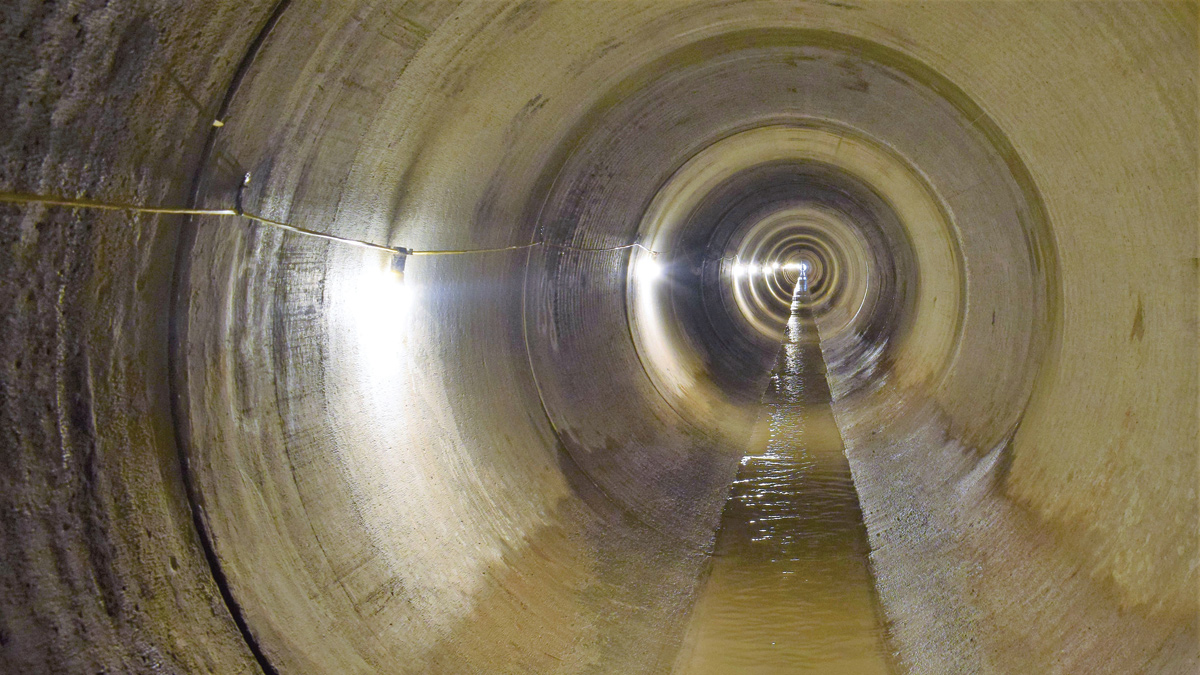
450m shot 1800mm diameter concrete pipe – tunnel beneath M4 crossing - Courtesy of Lewis Civil Engineering
The Frome Valley Relief Sewer scheme represents a £15m capital investment by Wessex Water to provide additional capacity for the continued development within the North Bristol area. It is the third phase out of a total of four phases which will see wastewater flows diverted from South Gloucestershire to Avonmouth Sewage Treatment Works in Bristol with its improved treatment facilities. The scheme is in its final phases with approximately 5km of 1200 to 1800Ø pipe now installed by varying installation methods. The gravity sewer connects Iron Acton (to the north of Frampton Cotterell), with Bradley Brook (on the north side of Bristol) and will convey pass forward flows of 400l/s from Hoovers Lane CSO. In addition to conveying flows, the pipeline provides 8,000m3 of internal sewage storage which is optimised through the provision of 5 (No.) actuated flow control penstocks.
Design and build
Construction of the Frome Valley Relief Sewer Scheme required overcoming several major obstacles which included crossings of the M4, three ‘main rivers’ including the River Frome, four HP gas mains (including the 48” 80Bar Seabank main and the high-pressure ESSO Oil pipeline) alongside the usual services and major roads. A challenging project in all regards.
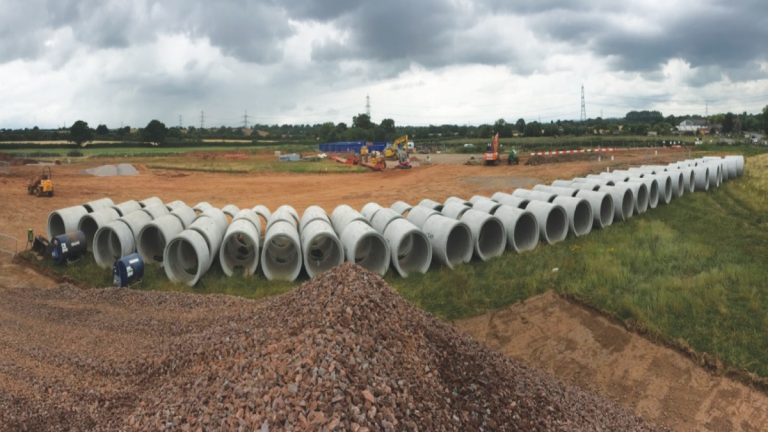
Main site compound with recycling facility established – Courtesy of Lewis Civil Engineering
The scheme was awarded to Lewis Civil Engineering (LCE) – now (Dec 2022) Envolve Infrastructure – as a design and build contract in October 2016 with a start on site date of March 2017, leaving only 6 months for the detail design of the scheme. Lewis Civil Engineering employed the services of OPUS International Design Consultants and worked tirelessly with them to optimise the route and overcome the numerous construction obstacles.
The finalised design developed married all available technology with construction efficiency with 1.6km of the route to be installed by tunnelling, with the remaining 3.4km by open cut at depths of up to 7m in hard sandstone rock. Three tunnel sections proved necessary to minimise the impact of the project on both landowners, environmental and third parties, a primary driver in the route selection; the first was a 410m 1800Ø shot under the M4, the second a 150m 1500Ø shot in close proximity to housing and roads, with the final length comprising three shots totalling 1050m. Two Intermediate shafts at depths of 12m were required at changes of direction in the final length. The open cut section comprised 470m 1800Ø and the remainder at 1200Ø.
The largest challenge of the scheme was determining a route that could physically be constructed with levels being gravity constrained by connection points at both ends while accommodating the features and services which couldn’t be diverted throughout its length. In total, 14 critical crossings were identified, seven of which it was not possible to divert. A further constraint was gradient, which was detailed in the works information as not exceeding 1:900. The River Frome in particular posed a challenge to these constraints. The team overcame this when a detailed survey of the river bed during route development proved that the outline design crossing point was not viable, and any crossing was going to require a relaxation of both client specification and EA regulations to permit a crossing to take place.
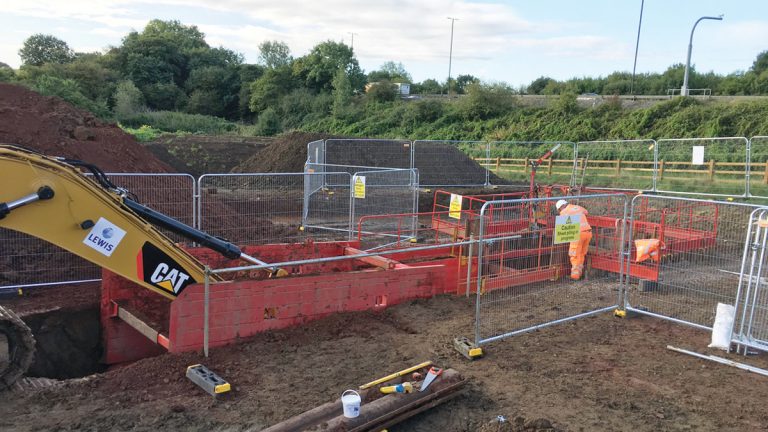
1800mm diameter open cut from reception of M4 tunnel drive – Courtesy of Lewis Civil Engineering
Lewis Civil Engineering worked very closely with the Wessex Water Environmental team and the EA to develop a detailed solution requiring only 300mm from top of pipe to the river bed. Sewer gradients were also relaxed further to 1:950. This concession allowed the profile to be lowered by a further 500mm over the 4km upto the River Frome crossing point and allowed the team to propose a solution. The 1200Ø sewer was replaced by a triple 675Ø crossing using steel pipes and a concrete capping slab with river boulders cast in. Smaller river bed material then naturally fills in the gaps between boulders resulting in a natural looking river bed. This crossing was carried out to the accolade of the Environment Agency and was a showpiece environmental success. Testimony to the efforts of the pre-construction team.
Tunnelling
Another key success measure for the scheme was the method of crossing the M4 motorway with no alternative route possible. Lewis Civil Engineering liaised closely with Highways England in order to obtain a licence to tunnel under the M4. Additional site investigation work was identified in order to gain confidence in ground make up, and consequently three further boreholes were sunk in close proximity to the proposed tunnel alignment. A band of competent mudstone was identified which was ideal to ensure the integrity of the tunnel. One of the boreholes also identified unusually high concentrations of CO2. The solution was to design and install a forced air supply throughout all tunnelling works with an advanced monitoring system installed with 24-hour monitoring to ensure trigger levels were not reached. The installation of this system with additional air-lines to the TBM face, coupled with a detailed rescue plans provided a safe system of work and ensured the success of this key element.

Preparation for 1800mm diameter 25m deep drive – Courtesy of B&W Tunnelling Ltd
Tunnelling contractor B&W Tunnelling Ltd was appointed to construct the tunnelled sections with tunnelling commencing in July 2017, progressing at approximately 15m per day using a LOVAT type TBM, in the open face mode.
Zone of influence
To minimise the construction duration beneath the M4 crossing, construction was switched to a 24-hour, 7-day, operation whilst tunnelling within the zone of influence below the M4. Highways England stipulated that the M4 carriageway had to be monitored 24/7 from the moment the TBM entered the zone of influence until the tunnel had been stabilised by grouting up. Robotic total stations were used to get continuous readings during this operation, but deflection proved to be absolutely minimal with no trigger points being reached.
Open cut
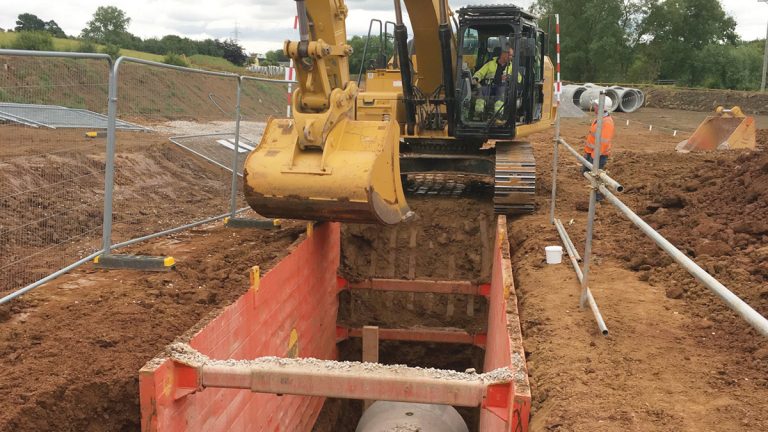
45t excavator laying open cut sections of pipework – Courtesy of Lewis Civil Engineering
The open cut sections of the work provided major challenges, with Lewis Civil Engineering’s expertise proving critical in key areas:
- Gradient: Laying at a grade of approximately 1mm/metre with pipe diameters up to 1800mm is a challenge in every regard. With distances of up to 600m between manholes pipe lasers become distorted and factors such as curvature of the earth start to become factors which need consideration. The LCE Engineering team demonstrated exemplary controls throughout integrating Quality Assurance process in to construction with a robust Inspection and Test Plan to ensure levels were achieved.
- Depth: Over 1km of the pipe route was at depths exceeding 6m, in a combination of both sandstone and mudstone rock. Ground levels were reduced by bench cutting by approximately 1m, with 35t excavators fitted with hydraulic breakers and rock wheels removing the hard rock.
- Ground conditions: Approximately half of the pipe route was favourable with fractured mudstone overlain with approximately 2m of clay. The second half however, consisted of very hard pennant sandstone over lain with a thin layer of topsoil. In the hardest and deepest sections progress fell dramatically with patience proving necessary.
- Materials: The 5km of new pipeline involved shifting approximately 100,000t of material. A major success measure for the LCE/Wessex environmental teams was proving the suitability of the excavated material for processing and recycling. A mobile crushing and screening unit meant that pipe bedding could be produced from the sandstone, and also enabled as-dug material to be used as selected trench backfill. A huge environmental gain and a great reward for the project team.
- Open cut crossing of River Frome: The pipeline was installed via a half and half style crossing. River flows were diverted away from the working area using a complex dam system allowing the triple 675Ø pipeline to be installed to the middle of the river. Flows were then diverted to the other side allowing the sewer to be completed. Environmental standards were maintained throughout.
- PR: The route of the sewer crossed two Equestrian centres, home to approximately 40 competition level horses and an international cross-country course. It was imperative that the businesses were able to function as throughout scheme delivery. Lewis Civil Engineering liaised closely with the owners on a daily basis during construction and ensured that the Cross Country course (which crossed the working easement) was open for all key pre-agreed periods/events. Wessex Water constructed several equine features to replace those lost to the working easement.
Actuated penstocks
The sewer has also been designed for storm water storage. Approximately 8,000m3 of storage volume is provided through 5 (No.) actuated penstocks located at strategic locations along the route. These will close sequentially starting with the most downstream as each section is filled.
Sewer levels are monitored along the route via ultra-sonic sensors and once storm flows have passed, the stored volume is allowed back into the network; a fully integrated control solution.
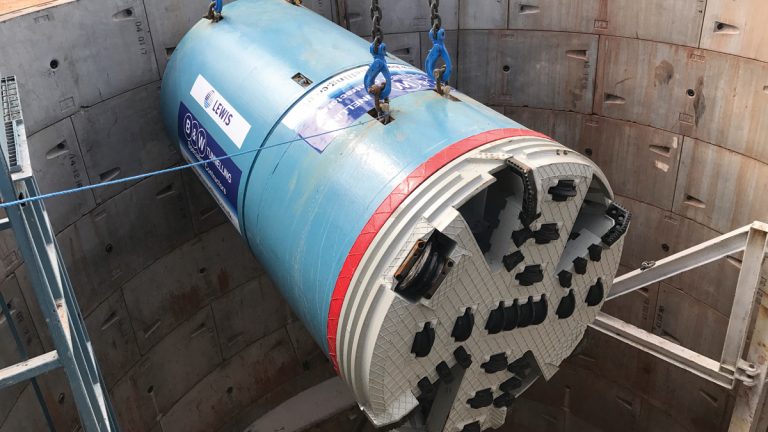
TBM launch from drive pit – Courtesy of Lewis Civil Engineering
Summary
The delivery of the Frome Valley Relief Sewer Scheme is nearing completion with the civil elements largely complete; all tunnelled sections have been accomplished and all 5km of pipe is laid and final connections made. The mechanical and electrical install of the actuated penstocks is well underway, with a view to the scheme being reinstated and de-mobilised by October 2018 in line with the original programme.
The project has been difficult and challenging but has ensured that development can continue in the North Bristol region with a robust strategic improvement to the sewage network. The scheme has been delivered to outstanding Quality and H&S standards and is testimony an aligned project delivery team between Lewis Civil Engineering and Wessex Water.





